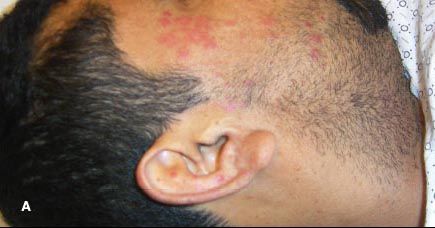- Clinical Technology
- Adult Immunization
- Hepatology
- Pediatric Immunization
- Screening
- Psychiatry
- Allergy
- Women's Health
- Cardiology
- Pediatrics
- Dermatology
- Endocrinology
- Pain Management
- Gastroenterology
- Infectious Disease
- Obesity Medicine
- Rheumatology
- Nephrology
- Neurology
- Pulmonology
Henoch-Schönlein Purpura in an Adult Man
This 40-year-old man presented with fever and a generalized, painful, nonpruritic rash of 2 days’ duration. The rash first appeared on his face then spread to his hands, buttocks, and lower extremities. Two weeks earlier, he had an episode of severe rhinitis followed by high fevers, chills, muscle aches, and ankle pain.

This 40-year-old man presented with fever and a generalized, painful, nonpruritic rash of 2 days’ duration. The rash first appeared on his face then spread to his hands, buttocks, and lower extremities. Two weeks earlier, he had an episode of severe rhinitis followed by high fevers, chills, muscle aches, and ankle pain. The patient’s only medication was ibuprofen for rhinitis. He denied a family history of autoimmune disease, recent vaccinations, exposure to tuberculosis, arthropod or animal bite, drug allergy, substance abuse, travel, or sexually transmitted disease. Review of systems yielded negative results.
The patient’s temperature was 37.7°C (100°F); heart rate was 110 beats per minute; blood pressure and respiration rate were normal. He had erythematous macules and plaques on his face (A) and hemorrhagic bullae with central necrosis and crusts on his buttocks and lower extremities (B). Gram stain of blister fluid was negative for a pathogen.
Treatment with piperacillin/tazobactam was started. However, the patient remained febrile and acute, painful arthritis of the ankle, elbow, and wrist developed. This was accompanied by microscopic hematuria (3+ hemoglobin, 25 to 50 erythrocytes per high-power field), a C4 level of 17.9 mg/dL (normal, 19 to 52 mg/dL), an IgA level of 509 mg/dL (normal, 66 to 433 mg/dL), and rheumatoid factor level of 46 IU/mL (normal, less than 14 IU/mL). Further laboratory testing revealed polymorphonuclear leukocytosis. Abdominal ultrasonography revealed an accessory spleen and increased bowel gas. Findings on chest radiograph, echocardiogram, and abdominal CT scan with angiogram were normal. Serological results indicated previous rickettsial, Cytomegalovirus, and Epstein-Barr virus infections. Cultures of blister fluid, blood, and urine remained sterile.

The rash with fever, arthritis, hematuria, and elevated serum IgA level (and its dermal deposition on direct immunofluorescence) were consistent with Henoch-Schönlein purpura. This cutaneous vasculitis typically involves the skin, gut, and glomeruli and is associated with arthralgia or arthritis.1 Its histopathological hallmark is leukocytoclastic vasculitis and IgA, C3, and fibrin deposits in the blood vessel walls. Clinically, erythematous papules or macules appear early, followed by palpable purpura distributed on the dorsal surface of the lower extremities and the buttocks. The lesions may become hemorrhagic and even necrotic. GI involvement in the form of bowel angina or ischemia can manifest as abdominal pain after meals, occult blood loss, vomiting, diarrhea, and massive colorectal bleeding.2 Renal involvement is characterized by hematuria, proteinuria, and renal failure. Although not routinely required, skin and renal biopsies can be helpful in cases of diagnostic difficulty.
Henoch-Schönlein purpura is usually self-limited. This patient was treated with oral corticosteroids to relieve his joint and skin symptoms. At follow-up, the rash had resolved.
References:
REFERENCES:1. Jennette JC, Falk RJ, Andrassy K, et al. Nomenclature of systemic vasculitides. Proposal of an international consensus conference. Arthritis Rheum. 1994;37:187-192.
2. Stancanelli B, Vita A, Vinci M, et al. Bleeding of small bowel in Henoch-Schönlein syndrome: the successful diagnostic role of video capsule endoscopy. Am J Med. 2006;119:82-84.
